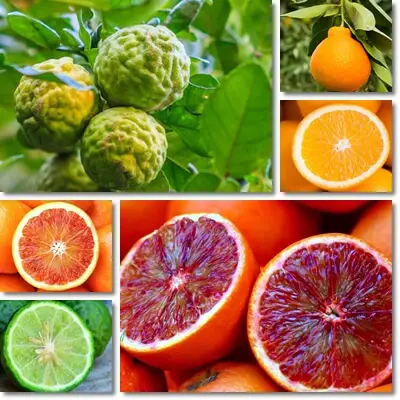What’s your favorite type of orange and why do you like it? There are so many different types of oranges, from the common sweet orange to the mandarin orange to the tangerine to the blood orange, Bergamot and bitter orange, and these are just a few varieties. Each type of orange has something special about it, whether it’s a sweeter taste, a more citrussy flavor, more juice, a bolder color, lack of acidity or seeds, or unique bioactive chemicals with specific health benefits. But just how many types of oranges are there and what are some of their biggest benefits and uses?
Sweet orange varieties
- Common orange varieties
- Blood oranges
- Navel oranges
- Acidless oranges
- Mandarin oranges: clementines, satsumas, tangelos, tangerines, tangors
Bitter orange varieties
- Seville orange, sour or bitter orange
- Bergamot orange
- Trifoliate orange

Acidless oranges
Acidless oranges are varieties of sweet orange with little acid. The low acidity is due to a low content of organic acids that occur in the citrus fruit naturally (e.g. citric acid). Of all the varieties of oranges, acidless oranges are the best choice for anyone with acid reflux disease (GERD), gastritis or a stomach ulcer because they are the least likely to contribute to and worsen these conditions, when consumed reasonably of course. And a few interesting facts: acidless oranges are sometimes called sweet oranges because of their lack of sharpness or sourness, but this same characteristic that makes people with acid reflux or gastritis tolerate them better is also what makes the oranges spoil faster.
Bergamot orange
The Bergamot orange (Citrus bergamia) is one of the most popular types of oranges, likely a cross between the bitter orange and lemon. Unripe Bergamot oranges have lime green rind and flesh, but are a lemon yellow color when ripe both inside and out. The peel is thick and bumpy, more in some varieties than others, and the orange tastes both sour and bitter.
The Bergamot orange peel is used to make oil of bergamot, an essential oil heavily used in perfumery, cosmetics and the food industry as a flavoring. Bergamot oranges are rich in bioactive components such as brutieridin and melitidin which have cholesterol lowering properties, but the fruit should be consumed reasonably because it can cause acid reflux, worsen gastritis or, when used topically, leads to photosensitivity that can cause skin irritation and an increased risks of sun damage upon exposure to sunlight.
Bitter orange
Also known as the Seville orange or sour orange, the bitter orange (Citrus aurantium) is presumably a cross between the mandarin orange and pomelo. The bitter orange occurred naturally in the wild and was picked up for cultivation during Moorish rule in Spain around the 10th century. Bitter oranges can taste bitter, sour or excessively acidic and as a result are not typically eaten raw, but rather used for making traditional orange marmalade and orange liquors.
Bitter orange peel is used as a dietary supplement for weight loss, to suppress appetite. Find out more about the benefits and side effects of bitter orange for weight loss.

Blood orange
The blood orange (Citrus sinensis) is a cultivated variety of sweet orange with pink-red to red-purple or dark reddish brown flesh, and red juice. In some varieties, the peel is a uniform golden yellow color with a slight orange tinge, and in some it’s tinged dark red, same as the flesh. The spongy pith between the flesh and rind is either white or tinged with red. Like many varieties of oranges, blood oranges have occurred as a natural mutation and have been picked up for cultivation from there.
Blood oranges and blood orange juice are rich in anthocyanin antioxidants such as chrysanthemin with anti-inflammatory and anticancer properties. The same antioxidant also occurs naturally in purple corn, red raspberries, acai berries, lychee fruit and elderberries. All varieties of blood orange also have a good content of vitamins C and B9.
Cara Cara orange
The Cara Cara orange (Citrus sinensis), also known as the Cara Cara red navel orange, is a variety of sweet navel orange with pink-red grapefruit-like pulp and a golden yellow-orange peel, sometimes with various degrees of pink-red. The variety is seedless, low-acidic, with a pregnant sweet taste and somewhat less pith than other orange varieties. Cara Cara oranges are a source of red carotenoid antioxidants, primarily lycopene, with proven antioxidant, anti-inflammatory and blood pressure lowering properties.
Calamondin orange
While not a true orange, Calamansi or the Calamondin orange (Citrus microcarpa) is a cross between the mandarin orange and kumquat. It is also called a Philippine lime or lemon because of its sour taste, and preferred for uses such as marmalades and other preserves. The Calamondin orange is a small, spherical orange variety with orange peel and flesh and large seeds. It’s easy to peel and high in organic acids and carotenoid antioxidants, with a rich flavor profile with sweet tangerine, apricot and lemon flavor notes.
Chinotto orange
Best known as the myrtle-leaved orange, the chinotto orange (Citrus myrtifolia) is a variety of orange from Italy and South France. It’s used to make the popular Chinotto soda, a dark-colored, cola-like soft drink with a bittersweet taste. Chinotto oranges are small and used for making Italian digestifs.
Clementine, or clementine orange
Clementine oranges (Citrus clementina) are not considered true oranges, but rather culinary oranges due to their similarity to true oranges. Clementines are tangors, a tangor being a type of citrus fruit similar to or derived from true oranges. The clementine is presumably a cross between the sweet orange and the mandarin orange. You can tell clementines apart by their smooth, glossy rind that is easy to peel.
Clementine rind and flesh are both a deep orange color. Clementine oranges are the easiest to peel of all orange varieties, with low acidity, a pregnant sweet taste (but sharp and sour if underripe) and mild to strong flavor intensity. The variety is rich in carotenoid antioxidants with vitamin A activity and benefits for eyesight, skin and the immune system. Seedless clementine oranges make a great snack for kids because they are extremely easy to peel, as well as nutritious.
Jaffa orange
The Jaffa orange is a type of common sweet orange whose particularity is a thick, deep orange peel. The variety is cultivated for both its peel, and as an eating-orange. The Jaffa orange is quite easy to peel and stores and ships well due to its thick peel. It’s flavorful, both sharp and sweet, with a strong orange taste.
Mandarin orange
The mandarin orange, or simply mandarin (Citrus reticulata), is actually one of the parents of the common sweet orange, the other being pomelo. Mandarin oranges are typically smaller and have a particular appearance: flattened at the top and bottom, or oblate. Mandarines taste quite sweet and flavorful, and are one of the low acidity types of oranges. They are fairly easy to peel and have deep orange peel and flesh. An advantage of the mandarin orange is that it separates into segments easily. Mandarin oranges are a good source of vitamin C and contain small amounts of pro-vitamin A, vitamins B1, B6 and B9, potassium, magnesium and phosphorus. They are often sold with stems and leaves. Varieties include the tachibana orange (Citrus tachibana, or Citrus reticulata tachibana), kishu mikan or kishu mandarin or baby mandarin (Citrus kinokuni ex Tanaka), Nanfengmiju
Minneola orange
The Minneola orange (Citrus × tangelo) is a type of tangelo, a cross between a mandarin orange or a mandarin orange hybrid, and a pomelo. It’s also known as a Honeybell orange due to its sweet taste and bell-like shape. Minneola oranges have a thin, deep orange or red-orange rind, and deep orange flesh, and are extremely juicy and sweet, with low acidity. They quite easy to peel and make a great eating orange.
Navel orange
The navel orange (Citrus sinensis) is a variety of the common sweet orange with a distinct navel-like protrusion at the top. The navel is actually a second fruit which, in some navel oranges, is actually developed enough that is resembles a tiny orange (even segments may be visible). Navel oranges are the typical orange, with a pregnant acidic and mildly sweet taste, and a light bitter aftertaste, and lots of juice. The flavor is particularly refreshing and vivid, great for making orange juice. The rind is deep orange and thick, somewhat easy to peel, but as easy as that of clementines or tangelos such as Minneolas or Orlando oranges.
Orlando oranges
Orlandos, Orlando tangelos or Orlando oranges are one of the more popular varieties of tangelo orange, a cross between a mandarin orange or a mandarin orange hybrid, and a pomelo or a grapefruit. Orlandos are large and sweet, similar to Minneolas. The variety has a neck at the end with the stem and is slightly flattened at the other end, with deep orange or reddish orange rind and juicy, orange flesh.
Satsuma mandarin, or satsuma orange
Satsuma (Citrus unshiu) is also known as the satsuma orange, cold hardy mandarin, satsuma mandarin or satsuma tangerine (tangerines are mandarin hybrids). It’s one of the sweetest varieties of oranges, or mandarin oranges, with a leathery, deep orange or reddish-orange rind that is easy to peel. In some climates, satsumas can be ripe even though their rind may still be green. Satsumas have few seeds and known to separate into segments easily.
Tangelo orange
The tangelo orange, or simply tangelo, is a cross between a Citrus reticulata variety such as mandarin orange or a mandarin orange hybrid (tangerine), and a pomelo or a grapefruit. Tangelo oranges are sweet and fragrant, with deep orange or reddish orange rind and sweet, juicy, orange flesh. Varieties of tangelo oranges include Minneola, Orlando and Honeybells. Fruits have a distinguishable neck-like protuberance at the end with the stem. Tangelo oranges are one of the sweetest types of oranges, together with mandarin oranges. Colder climates produce the sweetest tangelos.
Tangerine, or tangerine orange
Tangerines (Citrus reticula or Citrus tangerina) are hybrids of the mandarin orange. The classification system of tangerines is iffy, to say the least, as any deep orange to reddish-orange mandarins and mandarin hybrids can be considered tangerines. These types of oranges are smaller and not quite spherical, but have a stronger flavor intensity compared to sweet oranges. Tangerines are less acidic than the common sweet orange which allows for their sweetness to stand out, despite being less sweet than mandarins.
Tangerines are high in vitamin C with anti-inflammatory and antioxidant benefits and help stimulate collagen production for more youthful skin and fewer wrinkles. They have small amounts of fiber and pro-vitamin A antioxidants, potassium and magnesium, vitamins B1 and B6. They are best eaten fresh, but can also be juiced, and the peel is great for use in baked goods.
Tangor
The tangor (C. reticulata X C. sinensis) is a cross between the sweet orange and the mandarin orange, so somewhat of an orange. There are about a dozen officially recognized varieties, but since oranges and mandarins hybridize naturally, there may very well be many more. Tangors have a thick rind that is fairly easy to peel and a deep orange color and sweet and moderately sharp taste with a strong flavor profile. Examples of tangor varieties: the King orange, the Honey Tangerine or Murcott and the Setoka orange.
Trifoliate orange
Also known as the Japanese or Chinese bitter orange, the trifoliate orange (Citrus trifoliata) is a lime-sized variety of orange with a somewhat bumpy, yellow peel with a light fuzz. The flesh is light yellow, the color of lemon pulp, with lots of large, cream-white seeds. The ratio of flesh to seeds is almost equal. Because of this and the taste, trifoliate oranges are commonly used for marmalades or the peel dried and used as a condiment for sweet and savory dishes.
